info@chinaadventure.org
86-18008011324
Search
Chengdu, the capital city of Sichuan Province in China, is renowned for its rich tea culture and the exquisite charm of its teahouses. For centuries, tea has played a vital role in the lives of the people of Chengdu, not only as a beverage but also as an integral part of their social and cultural rituals. The teahouses in Chengdu are not just places to enjoy a cup of tea; they are vibrant hubs of social interaction, where locals and tourists alike gather to relax, chat, and immerse themselves in the city's unique atmosphere.
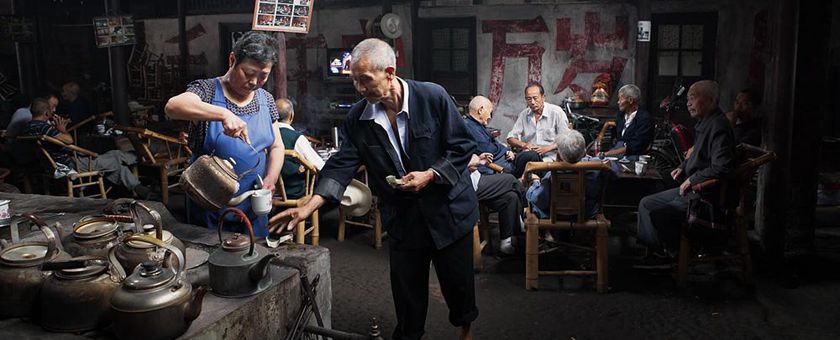
Tea has been cultivated in the Sichuan region for thousands of years, and Chengdu is at the heart of this tea-rich land. The city's tea culture dates back to the Tang Dynasty, when tea drinking became popular among the elite. Over the centuries, tea has become deeply ingrained in the daily lives of the people of Chengdu, symbolizing hospitality, friendship, and harmony. In fact, tea is often considered the "elixir of life" in Chengdu, with its numerous health benefits and soothing qualities.
Chengdu is home to a myriad of teahouses, each with its own unique charm and history. One of the most famous teahouses in the city is the Heming Teahouse, located in the heart of Chengdu's historic Jinli Street. This teahouse is known for its traditional architecture, elegant decor, and a wide selection of teas. Another renowned teahouse is the Wenshu Monastery Teahouse, situated within the tranquil surroundings of the Wenshu Monastery. It offers a serene environment where visitors can enjoy a cup of tea while admiring the beautiful gardens and ancient Buddhist relics.
By the way, if you are also interested in local food, please check Famous Local Restaurants for Foodies.
There is no business meeting, no celebrity anecdotes, no playing mahjong, only performance on the front stage of traditional Sichuan opera. The people who know and love Sichuan opera can understand what the opera actors and actress are singing, but for the layman to see a lively show is also good. Drinking a cup of covered-bowl tea, eating a few plate melon seeds peanuts and Chengdu snacks, watching characteristic show of changing face, spitting fire, and singing opera...in there you may feel that time seems to be back in one hundred.
Representative teahouse: Yingxiang narrow patio, Shunxing Old Teahouse, Shu Style Elegant and Charm Tea House.
► Shunxing Old Tea House (顺兴老茶馆)
Shunxing Old Tea House, a teahouse full of Chinese pioneering extremely national characteristics of the Oriental Tea Culture History Museum which is located in Chengdu international convention and exhibition center on the third floor. It is refer to Chengdu famous ancient tea house, tea culture and hire senior experts, ancient building experts and famous folk artists to carefully build a set of Ming and Qing style architecture which is in collection of wall carving, tracery, wood, furniture, tea utensils, clothes and tea art.
Shunxing Old Tea House is not only a simple dinning place, but the place of displaying and experiencing “land of abundance”--Sichuan. Based on the characteristics of traditional classic cuisine, famous snacks, Sichuan hot pot, Sichuan covered-bowl tea, Sichuan opera face-changing performance, and Sichuan folk customs, Shunxing provides people a chance to experience the traditional way of life in Chengdu as shown in the dinner and tea at the same time. Shunxing decoration is in combination of western Sichuan classic style with the modern fashion style, which belongs to the model of Chinese neoclassicism.
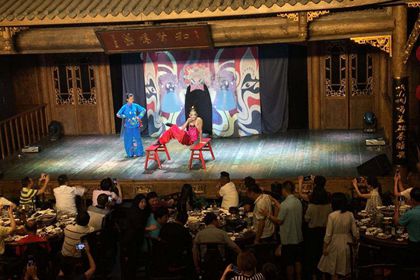

Chengdu people love to do a lot of things in tea houses, playing mahjong, playing cards, talk about business. But if people can only choose one thing, that is chatting. Listening to the interesting story is a pleasure. Where to listen the most beautiful story? The answer is Chengdu storytelling teahouse. The storytelling here is vivid with critical spirit of sharp observation of social dynamics and also humorous. Drink a bowl of scented tea and listen to storytelling of Chengdu local life. You can relax yourself here.

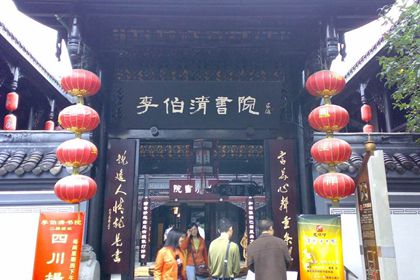
► Boqing Li Academy (李伯清书院)
Boqing Li Academy is more than 600 square meters, and is divided into two floors, in the form of a traditional three-section compound. Boqing Li said: "Wenshu Monastery is the holy land of Buddhism with good geomantic omen; here is located in the downtown, traffic was relatively large that gather enough popularity." At present, most of young people accept a lot of foreign culture, the emergence of Wenshufang highlights the local culture and reflects a kind of humanistic spirit. Boqing Li would ome here to speak on an irregular basis, may also invite Bashu comedian, such as Shenfa and Liu Deyi.
Walking into Boqing Li Academy, people will hear the sound of a dulcimer. On the second floor, people drink covered-bowl tea and listen to the dulcimer, which is very old Chengdu style! The price is not expensive! At 2 PM to 4 PM, the price is cheaper of 20 Yuan/person. At 8 o 'clock in the evening to 10 o 'clock in the end, price is a little expensive of 60 Yuan/person
Add: Wenshufang, Qingyang District, Chengdu (成都市青羊区文殊坊)
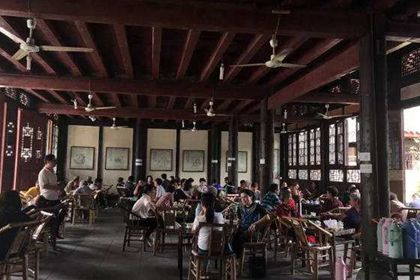

Tea and Zen, as two of the most life essence that do not need language, use common heart to taste tea fragrance quietly. Monastery, sunshine, incense burner, shade, bowls, tea, all of these provide you with a peaceful mind of “zen and tea mixing together” atmosphere and mood in the world that fame and fortune coming and going.
Representative teahouse: Jamchen Lhakhang Monastery Zen Tea House
► Jamchen Lhakhang Monastery Zen Tea House (大慈寺茶馆)
Located within Jacmchen Lhakhang Monastery, there is a traditional teahouse which is very famous in Chengdu. Lots of people gather there and some of the old people playing mahjong or playing cards. Drinking tea there is cheap. The atmosphere of the monastery is very good. Sometimes you can also listen to evensong in Sanskrit by the monks which can let you be in a quiet and relaxing environment.
Address: Jamchen Lhakhang Monastery, Dongfeng Road first section, Jinjiang District (锦江区东风路一段大慈寺)
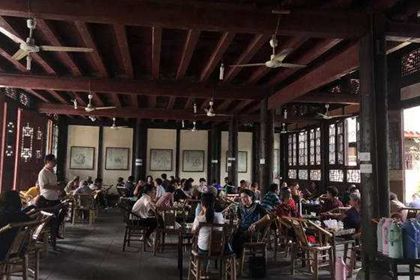
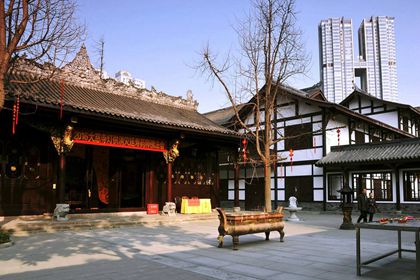
Birdsong ups and downs; different size dogs are gathering here with their masters; in the hundreds of seats of outdoor teahouse, the covered-bowl tea is steaming with tea aroma; Armed with what the waiter run back and forth to serve the guests in the teahouse with cooper pot; vendors that selling Toufu pudding and sugar painting, etc.; Chengdu people are reading newspapers, playing mahjong and cards, chatting, or basking in the sunshine or dozing off. This lifestyle in Chengdu is very cosy.
Representative teahouse: the People's Park Heming Teahouse, Riverside Tea Garden
► Heming Teahouse (鹤鸣茶社)
It is the most famous teahouse in the People's Park, and it is old teahouse with some years. Tea is not expensive with great variety. Also there are some snacks. Old bamboo chair, antique pavilion, as long as there is sun, the yard is filled with chairs. Men and ladies will play cards there. There are also some foreigners, reading books and chatting together. Customers can drink tea for a noon, squinting to kill time, which is really comfortable.
Address: the People’s Park, Qingyang District (青羊区人民公园)
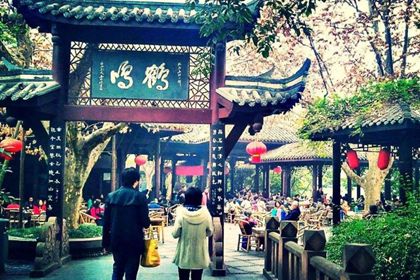

Chengdu tea culture is extensive and profound with historical source, Tea Culture Museum uses history objects and art performance to restore, protect and inherit Chengdu humanities styles and features, relaxation, and folk culture preferably. Here you can visit all kinds of tea sets from ancient time to modern time, and through tea history introduction, fried tea workshop, tea experience area, you can appreciate the connotation and charm of Chinese tea culture.
Representative teahouse: Wenshufang Mahjong and Tea Culture Exhibition Hall.
► Wenshufang Mahjong and Tea Culture Exhibition Hall (文殊坊麻将与茶文化博览馆)
The first Mahjong and Tea Culture Exhibition Hall opened in Chengdu. The museum is located in Chengdu Wenshufang Baiyun Temple No.1. The museum collection has more than 500 relics, systematically introduces origin and development history of mahjong. Mahjong galleries were in possession of more than five hundred pieces of cultural relic’s collections, many of which are rare in the world.
Going into the Tea Culture Exhibition Hall, a refreshing tea aroma is spraying into your face. According to staff, the tea aroma is the result of a wall built with several pieces of brick tea. This kind of tea brick wall, except for a few hotels, it is unique in the expo pavilion of whole country. The Tea Exhibition Hall has tin kettle of Ming Dynasty, three-color hexagonal pot, boccaro teapot in the Qing Dynasty, Tibetan dragon ewer of more than four hundred pieces.
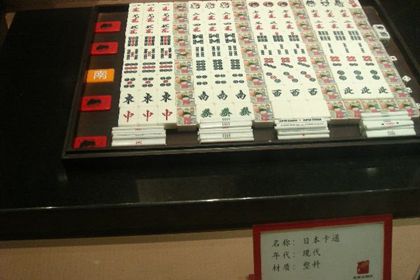
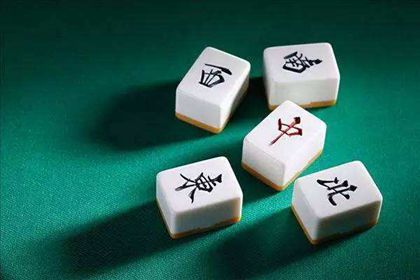
A few money, a cup of tea, a piece of square table, a few bamboo chairs, a pair of mahjong, these things gather together can make Chengdu people sitting in the teahouse for an afternoon. These teashops scatter on Chengdu streets. Countless unknown tea shops constitute the basic elements of the Chengdu tea culture.
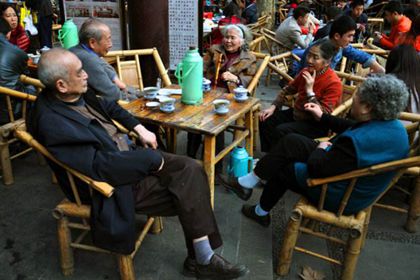
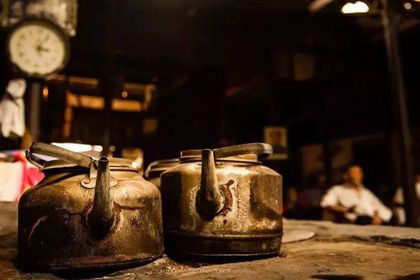
Tea ceremonies are an integral part of Chengdu's tea culture. These ceremonies are not just about brewing and serving tea; they are intricate rituals that reflect the principles of respect, mindfulness, and harmony. In Chengdu teahouses, visitors can witness and participate in these ceremonies, which often involve precise movements, elegant gestures, and the use of specialized tea utensils. These ceremonies not only enhance the flavor of the tea but also provide a deeper understanding of the art and philosophy of tea.
One of the most captivating aspects of Chengdu teahouses is their unique atmosphere. As soon as you step into a teahouse, you are greeted by the soothing aroma of tea and the gentle sounds of conversation and laughter. The teahouses are often adorned with traditional Chinese decorations, such as antique furniture, calligraphy scrolls, and delicate porcelain tea sets. The ambiance is relaxed and unhurried, allowing visitors to unwind and savor the moment. It is not uncommon to see groups of friends engaged in lively discussions or individuals lost in their own thoughts, all while enjoying a cup of tea.
Chengdu teahouses boast an impressive variety of tea, ranging from the well-known green tea and oolong tea to the more rare and prized Pu-erh tea. Each tea variety has its own distinct flavor profile and health benefits, making the selection process an adventure in itself. Some teahouses in Chengdu even offer specialized tea tastings, allowing visitors to sample different teas and learn about their origins and brewing techniques. Additionally, teahouses often serve tea-infused snacks and delicacies, such as tea-smoked duck and tea-flavored desserts, adding another layer of culinary delight to the tea-drinking experience.
To truly experience the authentic tea culture of Chengdu, it is recommended to spend some time immersing yourself in the teahouse scene. Take the opportunity to engage in conversations with locals, who are often more than happy to share their knowledge and passion for tea. Participate in tea ceremonies, learn about the art of brewing tea, and discover the stories behind each tea variety. By fully embracing the tea culture of Chengdu, you will gain a deeper appreciation for this ancient tradition and create lasting memories of your journey.
When visiting Chengdu teahouses, there are a few tips to keep in mind to ensure a pleasant experience. Firstly, it is advisable to research and choose teahouses that are known for their quality and authenticity. Secondly, be open to trying different tea varieties and ask for recommendations from the teahouse staff. Additionally, it is customary to pay for the tea and snacks consumed during your visit. Lastly, make sure to observe the teahouse etiquette, such as not touching the tea utensils and respecting the privacy of other patrons, to show your appreciation for the tea culture of Chengdu.
Chengdu teahouses have their own set of customs and etiquette that visitors should be aware of. For example, it is customary to pour tea for others before pouring for yourself, as a sign of respect. When receiving tea, it is polite to hold the tea cup with both hands as a gesture of gratitude. Additionally, it is customary to tap the table with two fingers to express thanks to the person who poured the tea. By observing these customs, you will not only show your respect for the tea culture but also enhance your overall teahouse experience.
Chengdu teahouses offer a captivating journey into the world of tea, where ancient traditions and contemporary lifestyles coexist in perfect harmony. From the rich history and cultural significance of tea to the unique charm and atmosphere of the teahouses, Chengdu provides an enchanting experience for tea enthusiasts and curious travelers alike. By immersing yourself in the authentic tea culture of Chengdu, you will not only discover the exquisite flavors of tea but also gain a deeper understanding of the profound connection between tea and the people of Chengdu. So, embark on this journey and let the charm of Chengdu teahouses captivate your senses.
we’ll reply you in 24 hours!
Copyright © 2012-2024 All Rights Reserved to chinaadventure.org